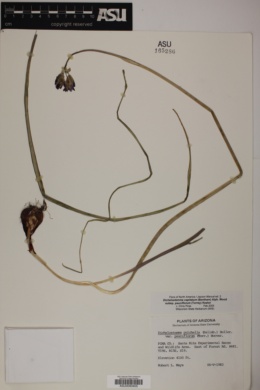|
|
|
|
Family: Asparagaceae
bluedicks
[Brodiaea capitata Benth., moreDichelostemma pulchellum var. capitatum (Benth.) Reveal] |
Leaves 2-3, 10-70 cm; blade barely keeled. Scape shorter than 65 cm, smooth. Inflorescences umbellate, dense, 2-15-flowered; bracts whitish to dark purple, ovate to lanceolate, 7-20 mm. Flowers horizontal or erect; perianth blue, bluish purple, pinkish purple, or white, tube narrowly cylindrical to short-campanulate, not constricted above ovary, 3-12 mm, lobes usually ascending or widely spreading, 7-12 mm; perianth appendages slightly reflexed distally, leaning toward anthers to form corona, white, lanceolate, 4-6 mm, apex deeply notched; stamens 6, smaller 3 on outer tepals alternating with larger 3 on inner tepals; outer filaments wider than inner at base, 2 mm; outer anthers 2-3 mm, inner 3-4 mm; ovary sessile, ovoid, 4-8 mm; style 4-8 mm; pedicel 1-35 mm. Dichelostemma capitatum is the most wide-ranging species in the genus, with great variation in habitat, morphology, and chromosome number (G. Keator 1992). Two subspecies are recognized here, after G. Keator (1991, 1993b), but many other subspecies and even separate species have been recognized. For example, D. insulare has been recognized because it is endemic to the California Channel Islands and Guadalupe Island and is larger than mainland plants. Dichelostemma capitatum ranges from northern Mexico through California, Oregon, Nevada, New Mexico, and possibly north to Idaho and Washington. Despite its great intraspecific variability, it is quite distinct from other species in the genus. It is the only species with six fertile stamens and epigeous germination, and it has unique corm, seed, and ovule characteristics. It also does not form hybrids with any other species, and it has even been placed in its own genus, Dipterostemon (P. A. Rydberg 1912). Recent anatomical and molecular data support the idea that this species is not directly related to the other members of Dichelostemma and perhaps is best treated as its own genus (R. Y. Berg 1996; J. C. Pires 2000).
FNA 2003 Duration: Perennial Nativity: Native Lifeform: Forb/Herb General: Perennial scapose herb from a large underground deep-seated corm (bulb); scape to 65 cm tall. Leaves: Basal, slender, 2-3 per plant, mostly shorter than scape, 10-70 cm long, 2-15 mm wide, the blade barely keeled, the margins scaberulous. Flowers: Purple or white, in open umbels of 2-15 flowers; bracts 8-15 mm long, broadly ovate, abruptly acuminate; pedicels slender, 2-10 mm long; tepals 6, connate into a tube at the base, separated into lobes and spreading above, deep violet-purple, rarely reddish purple or white, 12-18 mm long, the tube thin, 4-8 mm long, constricted at throat. Fruits: 3-angled capsule, 6-10 mm long with persistent style; splitting open to release seeds when mature. Ecology: Found on dry open ridges and grassy plains, especially on heavier textured soils such as clays and heavy loams, below 5,000 ft (1524 m); flowers February-May. Distribution: OR, south through NV and CA, east through UT, AZ, CO and NM; south to n MEX. Notes: A distinct spring perennial recognized by its fiber-covered bulbs; slender, linear, slightly-folded leaves; long stem (scape) which terminates in an inflorescence of many branches from a central point (umbel) with showy, purple flowers with 6 petals (tepals). Two subspecies recognized: subsp. pauciflorum has whitish bracts which are streaked purple, 2-5 flowers per inflorescence, and pedicels shorter than bracts; subsp. capitatum has dark purple bracts, 6-15 flowers per inflorescence, and pedicels are longer than bracts. Ethnobotany: Corms were eaten raw or cooked and eaten. Etymology: Dichelostemma comes from Greek dicha, bifid, and stemma, a garland or crown, referring to appendages on the stamens, while capitatum refers to the way the flowers form a head-like cluster. Synonyms: Brodiaea capitata, Dichelostemma pulchellum var. capitatum, Dipterostemon capitatus, Milla capitata Editor: SBuckley 2010, FSCoburn 2014, AHazelton |
|
|
|








_tn.jpg)






